MaryAnn Bernal's Blog, page 11
May 7, 2020
Spotlight on authors JJ Toner, Ellie Midwood, Rachel Wesson, Marion Kummerow, Chrystyna Lucky-Berger

Fun Factsstuff you probably didn't knowabout the writers ofThe Road to Liberation
JJ Toner
I could have been a famous actor. All I lacked was talent.
I could have served in WW2, but my feet were too flat, and I was too young.
I once played in a rock band. We made one record, now a rare collector’s item.
I like to discover a new word every day. Today’s word is “parergon.”
I could have been a professional golfer. All I lacked was talent.
Ellie Midwood
English is my second language.
I can’t cook to save my life.
I hardly feel any physical pain (I recovered from surgery without taking a single painkiller and usually don’t notice that I accidentally cut myself until I see actual blood).
As a teen and in my early twenties, I performed on stage at our local theater and was seriously considering becoming a director, but life had other plans, so now I’m writing about them:) Another profession I seriously considered was a medical one (go figure!), but I ended up becoming a writer instead. Not that I’m complaining.
One of my early jobs was teaching kids horseback riding.
Rachel Wesson
Contrary to some readers' beliefs, shared by my children, I didn't live through the war.
I fought off some bank raiders with a tea tray and teacups - Us Irish like our tea!
I once embroidered an Irish dancing costume just for fun - I can't thread a needle now.
In England, they think I am American due to my accent.
I can't hold a conversation in my native tongue.
Marion Kummerow
As a child, I wanted to be a fisherwoman or a doctor or an actress.
Now matured, I regret, I didn’t become an archivist or an archeologist or an anthropologist.
In my soul, I envy Robinson Crusoe.
I love all things classical: literature, music, art and would prefer living in the 19th century.
I’m highly responsible. If I fail to accomplish something important for myself or others, I feel terrible.
Chrystyna Lucyk-Berger
I wanted to be Grizzly Adams when I grew up, writing stories and books, being on television each week, living in a cabin in the mountains, and being followed about by a pet grizzly bear.
After surgery, I can’t feel the second toe on my right foot anymore, and I often dream that it just falls off at very inconvenient moments.
When I was ten, my grandmother asked me what I wanted to be. I said, “Storyteller.” She said, “How will you make money?” I said, “I’ll write books.” She said, “So, you want to be an author? You’ll have to marry a doctor or a lawyer to support you.” Wrong thing to say to a fiercely independent kid, so I said, “Then I’ll be a veterinarian and an author, like James Herriot.” Today my answer is, “Then I’ll just be a better author.”
My husband and I met anonymously on the Internet only to find out that we knew each other from other circles. And when that became clear, I danced a little jig and dreamt that night I’d be married to him by the following spring. And that happened. I really hope the toe-falling-off thing doesn’t, though.
I live in the mountains, in a cabin, where I stream Netflix and Amazon prime each week, write books and stories and have a dog and cat - who follow me about. The cat can have a grizzly temper. (Sometimes you gotta make compromises).
***
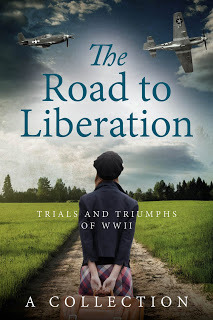
Riveting stories dedicated to celebrating the end of WWII.
From USA Today, international bestselling and award-winning authors comes a collection filled with courage, betrayal, hardships and, ultimately, victory over some of the most oppressive rulers the world has ever encountered.
By 1944, the Axis powers are fiercely holding on to their quickly shrinking territories.The stakes are high—on both sides:
Liberators and oppressors face off in the final battles between good and evil. Only personal bravery and self-sacrifice will tip the scales when the world needs it most.
Read about a small child finding unexpected friends amidst the cruelty of the concentration camps, an Auschwitz survivor working to capture a senior member of the SS, the revolt of a domestic servant hunted by the enemy, a young Jewish girl in a desperate plan to escape the Gestapo, the chaos that confused underground resistance fighters in the Soviet Union, and the difficult lives of a British family made up of displaced children.
2020 marks 75 years since the world celebrated the end of WWII. These books will transport you across countries and continents during the final days, revealing the high price of freedom—and why it is still so necessary to “never forget”.
Stolen Childhood by Marion KummerowThe Aftermath by Ellie MidwoodWhen's Mummy coming? by Rachel WessonToo Many Wolves in the Local Woods by Marina OsipovaLiberation Berlin by JJ Toner
Magda’s Mark by Chrystyna Lucyk-Berger
***About the Authors
Marion Kummerow:
Marion Kummerow was born and raised in Germany before she set out to "discover the world" and lived in various countries. In 1999 she returned to Germany and settled down in Munich, where she's now living with her family.
After dipping her toes with non-fiction books, she finally tackled the project dear to her heart. UNRELENTING is the story about her grandparents, who belonged to the German resistance and fought against the Nazi regime. It's a book about resilience, love, and the courage to stand up and do the right thing.
Marina Osipova:
Marina Osipova was born in East Germany into a military family and grew up in Russia, where she graduated from the Moscow State Institute of History and Archives. She also has a diploma as a German language translator from the Moscow State Institute of Foreign Languages. In Russia, she worked first in a scientific-technical institute as a translator then in a Government Ministry in the office of international relations, later for some Austrian firms. For seventeen years, she lived in the United States, where she worked in a law firm. Eventually, she found her home in Austria. She is an award-winning author and a member of the Historical Novel Society.
Rachel Wesson:
Rachel Wesson is Irish born and bred. Drawn to reading from an early age, she started writing for publication a few years back. When she is not writing, Rachel likes to spend her time reading and playing with her three kids. Living in Dublin, there are plenty of things to do, although the Cowboys and Indians of her books rarely make an appearance. To chat with Rachel, connect with her on Facebook - authorrachelwesson. To check out her newest releases, sign up to her mailing list.
JJ Toner:
My background is in Mathematics and computing, but I have been writing full time since 2005. I write short stories and novels. My novels include the bestselling WW2 spy story 'The Black Orchestra,' and its three sequels, 'The Wings of the Eagle,' 'A Postcard from Hamburg,' and 'The Gingerbread Spy.'
Many of my short stories have been published in mainstream magazines. Check out 'EGGS and Other Stories' - a collection of satirical SF stories. I was born in a cabbage patch in Ireland, and I still live here with my first wife, although a significant part of our extended family lives in Australia.
Ellie Midwood:
Ellie Midwood is a USA Today bestselling and award-winning historical fiction author. She owes her interest in the history of the Second World War to her grandfather, Junior Sergeant in the 2nd Guards Tank Army of the First Belorussian Front, who began telling her about his experiences on the frontline when she was a young girl. Growing up, her interest in history only deepened and transformed from reading about the war to writing about it. After obtaining her BA in Linguistics, Ellie decided to make writing her full-time career and began working on her first full-length historical novel, "The Girl from Berlin." Ellie is continuously enriching her library with new research material and feeds her passion for WWII and Holocaust history by collecting rare memorabilia and documents.
In her free time, Ellie is a health-obsessed yoga enthusiast, neat freak, adventurer, Nazi Germany history expert, polyglot, philosopher, a proud Jew, and a doggie mama. Ellie lives in New York with her fiancé and their Chihuahua named Shark Bait.
Chrystyna Lucyk-Berger:
Chrystyna Lucyk-Berger was born in Minnesota in 1969 and grew up in the culture-rich neighborhood of "Nordeast" Minneapolis. She started her writing career with short stories, travel narratives, worked as a journalist and then as a managing editor for a magazine publisher before jumping the editor's desk and pursuing her dreams of writing and traveling. In 2000, she moved to western Austria and established her own communications training company. In 2005, she self-published a historical narrative based on her relatives' personal histories and experiences in Ukraine during WWII. She has won several awards for her short stories and now primarily writes historical fiction. During a trip into northern Italy over the Reschen Pass, she stood on the edge of Reschen Lake and desperately wanted to understand how a 15th-century church tower ends up sticking out of the water. What stories were lying beneath? Some eight years later, she launched the "Reschen Valley" series with five books and a novella releasing between 2018 and 2021.
For more on Chrystyna, dive in at inktreks.com.
***
Where to By
Amazon USAmazon UKAmazon CA
Published on May 07, 2020 23:30
May 6, 2020
The Coffee Pot Book Club: #HistoricalFiction author, Mary Ann Bernal: An Author's Inspiration Crusader's Path
The Coffee Pot Book Club: #HistoricalFiction author, Mary Ann Bernal, is tal...: An Author’s Inspiration Crusader’s Path By Mary Ann Berna l In my ongoing interest in the human psyche and wh...
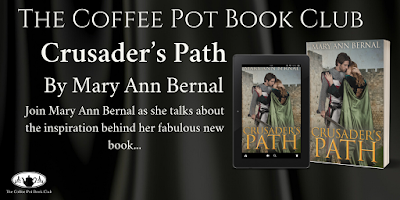
An Author’s InspirationCrusader’s PathBy Mary Ann BernalIn my ongoing interest in the human psyche and why people behave the way they do, I discovered most individuals react in the same way when coming in contact with a person who may or may not have a communicable disease.
When I had a bout of shingles a while back, I was fortunate – only one hand and wrist were affected, a few manageable lesions that did not spread, just five or six clusters lining one finger, easily covered with Band-Aids.
 Shingles.
Shingles.
While speaking to several coworkers, I noticed their peculiar behavior the minute I said the word shingles. They stepped away – distancing themselves a few feet from where I stood as if my covered finger would contaminate them.
Of course, I was not contagious, but the fear emanating after hearing the word shingles seemed to set protective gears in motion, leaving as quickly as one could without appearing rude.
What immediately came to mind was how people with infectious diseases had been treated throughout the centuries. The recent remake of Ben Hur in 2016 reminded me of Charleston Heston’s portrayal of Judah and how he interacted with his mother and sister, who had contracted the disease while in prison.
Ben-Hur (6/10) Movie CLIP - The Valley of the Lepers (1959)
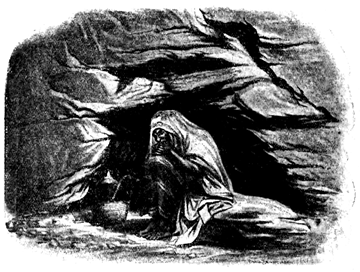 Lewis Wallace - Ben-Hur: Wikimedia.
Lewis Wallace - Ben-Hur: Wikimedia.
Throughout the years, a plethora of movies were made about the Crusades and leper warriors, such as King Baldwin IV of Jerusalem. The Order of Saint Lazarus of Jerusalem, a military order was established to care for the hospitalized lepers around 1119 AD.
Baldwin IV - The Leper King of Jerusalem - IT'S HISTORY
Hospitaller Order of Saint Lazarus of Jerusalem.Remember Richard the Lionheart joining the Third Crusade to fight his nemesis, the notable Saladin? And don’t forget the Robin Hood movies which reference the famous outlaw’s experiences fighting the Infidel. Recognizable names and places because of Hollywood, all filmed with creative license meant to entertain and are not necessarily historically accurate.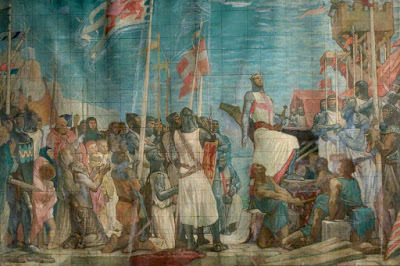 Philpot, Glyn Warren; Richard the Lionheart Embarks on the Third Crusade; Nottingham City Museums and Galleries: Wikimedia.However, in recent years, the atrocities of warfare have been articulated with documentaries and dramatic television series where the brutality of the age is showcased and not swept into the background. In Knightfall, we see a leper knight whose face is covered by a mask. Yes, there were warriors affected with the disease who fought valiantly during every campaign over the years.
Philpot, Glyn Warren; Richard the Lionheart Embarks on the Third Crusade; Nottingham City Museums and Galleries: Wikimedia.However, in recent years, the atrocities of warfare have been articulated with documentaries and dramatic television series where the brutality of the age is showcased and not swept into the background. In Knightfall, we see a leper knight whose face is covered by a mask. Yes, there were warriors affected with the disease who fought valiantly during every campaign over the years.
But I wanted to go back to the beginning, to the First Crusade, to understand what drove the warriors of Christ to leave their homes, enduring untold hardships for a holy cause. It took years to reach the Holy Land, a feat not everyone accomplished, dying en route from disease, starvation, and in battle.
Creating a narrative set during the First Crusade satisfied a two-fold desire to discern the truth about life in such a turbulent era.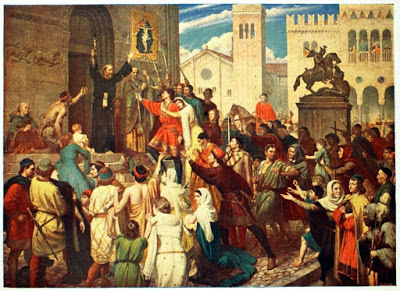 Wikimedia.
Wikimedia.
Lepers were shunned and, to this day, still bear the stigma for having the disease. Delving into the minds of human beings is fascinating because of the different perceptions. Where one sees a victim struck down by God, another sees an unfortunate soul, suffering from an infliction through no fault of their own.And what of the reasoning behind the Crusades, and what mitigating factors drove the men and women to travel to an unknown land. The peasant class had no clue as to what the undertaking meant, never having ventured out of their village.
I wonder if Urban II would have started his quest to free the Holy Land from the Infidel if he knew his mission would set off a series of events that has transcended the centuries. In our modern era, there is still a holy war being fought in the Middle East. With the advances in warfare, all that has changed are the weapons. Battles are still being fought in the name of God, religious wars, man-made, making the assumption God wills it. In reality, the quest for power and wealth drives a primeval need to dominate the weak, worldwide dominion, reminiscent of the saying, only the strong will survive.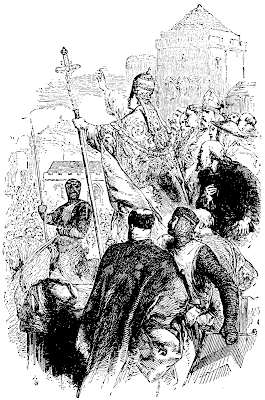 Wikimedia.
Wikimedia.
It took three years for the Princes’ Army to reach Jerusalem, where the remnants of a once-massive military force did what no one expected. The Christian flag flew above the tower of the Lord’s city, a hard-fought victory never to be repeated over the ensuing years.
As in Romeo and Juliet and the Outlander series, Crusader’s Path has more than one main character. The story takes an in-depth look at how leprosy and religious warfare affected the individual. Avielle, a commoner, conforms to the laws of the land, but her compassion for the afflicted grows because of her personal experience. Yet she must behave according to the mores of the time, and many of her decisions stem from having to live within those rules.
Etienne, on the other hand, defies accepted values, his status giving him license to do as he pleases. He casts everything aside as he follows his ducal lord, Robert, but he is not judged as Avielle would have been for the same infraction.
Whether or not you agree with their decisions reverts back to your perception of what is acceptable and what is not. Were the conditions and rules harsh in the Eleventh Century? Yes, they were. What would you have done in a similar situation? Can you feel empathy for Avielle and Etienne and even the ducal lord, Robert, whose selfishness fits his entitled persona? If you judge them according to the principles imposed in their century and not ours, would you be surprised by your verdict?Crusader’s PathBy Mary Ann Bernal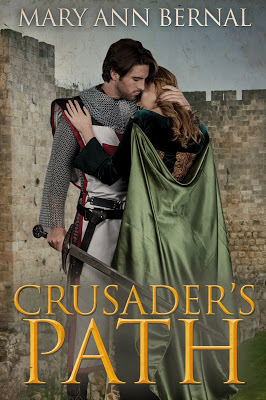
From the sweeping hills of Argences to the port city of Cologne overlooking the River Rhine, Etienne and Avielle find themselves drawn by the need for redemption against the backdrop of the First Crusade.
Heeding the call of His Holiness, Urban II, to free the Holy Land from the infidel, Etienne follows Duke Robert of Normandy across the treacherous miles, braving sweltering heat and snow-covered mountain passes while en route to the Byzantine Empire.
Moved by Peter of Amiens’ charismatic rhetoric in the streets of the Holy Roman Empire, Avielle joins the humble army of pilgrims. Upon arrival in Mentz, the peasant Crusaders do the unthinkable, destroying the Jewish Community. Consumed with guilt, Avielle is determined to die fighting for Christ, assuring her place in Heaven.
Etienne and Avielle cross paths in Constantinople, where they commiserate over past misdeeds. A spark becomes a flame, but when Avielle contracts leprosy, Etienne makes a promise to God, offering to take the priest cowl in exchange for ridding Avielle of her affliction.
Will Etienne be true to his word if Avielle is cleansed of the contagion, or will he risk eternal damnation to be with the woman he loves?
Pick up your copy ofCrusader’s PathAmazon
Mary Ann Bernal
 Mary Ann Bernal attended Mercy College, Dobbs Ferry, NY, where she received a degree in Business Administration. Her literary aspirations were ultimately realized when the first book of The Briton and the Dane novels was published in 2009. In addition to writing historical fiction, Mary Ann has also authored a collection of contemporary short stories in the Scribbler Tales series. Her latest endeavor is a science fiction/fantasy novel entitled Planetary Wars Rise of an Empire. Originally hailing from New York, Mary Ann now resides in Elkhorn, Nebraska.
Mary Ann Bernal attended Mercy College, Dobbs Ferry, NY, where she received a degree in Business Administration. Her literary aspirations were ultimately realized when the first book of The Briton and the Dane novels was published in 2009. In addition to writing historical fiction, Mary Ann has also authored a collection of contemporary short stories in the Scribbler Tales series. Her latest endeavor is a science fiction/fantasy novel entitled Planetary Wars Rise of an Empire. Originally hailing from New York, Mary Ann now resides in Elkhorn, Nebraska.
Connect with Mary Ann: Website • Whispering Legends Press • Twitter.

An Author’s InspirationCrusader’s PathBy Mary Ann BernalIn my ongoing interest in the human psyche and why people behave the way they do, I discovered most individuals react in the same way when coming in contact with a person who may or may not have a communicable disease.
When I had a bout of shingles a while back, I was fortunate – only one hand and wrist were affected, a few manageable lesions that did not spread, just five or six clusters lining one finger, easily covered with Band-Aids.
 Shingles.
Shingles.While speaking to several coworkers, I noticed their peculiar behavior the minute I said the word shingles. They stepped away – distancing themselves a few feet from where I stood as if my covered finger would contaminate them.
Of course, I was not contagious, but the fear emanating after hearing the word shingles seemed to set protective gears in motion, leaving as quickly as one could without appearing rude.
What immediately came to mind was how people with infectious diseases had been treated throughout the centuries. The recent remake of Ben Hur in 2016 reminded me of Charleston Heston’s portrayal of Judah and how he interacted with his mother and sister, who had contracted the disease while in prison.
Ben-Hur (6/10) Movie CLIP - The Valley of the Lepers (1959)
 Lewis Wallace - Ben-Hur: Wikimedia.
Lewis Wallace - Ben-Hur: Wikimedia.Throughout the years, a plethora of movies were made about the Crusades and leper warriors, such as King Baldwin IV of Jerusalem. The Order of Saint Lazarus of Jerusalem, a military order was established to care for the hospitalized lepers around 1119 AD.
Baldwin IV - The Leper King of Jerusalem - IT'S HISTORY
Hospitaller Order of Saint Lazarus of Jerusalem.Remember Richard the Lionheart joining the Third Crusade to fight his nemesis, the notable Saladin? And don’t forget the Robin Hood movies which reference the famous outlaw’s experiences fighting the Infidel. Recognizable names and places because of Hollywood, all filmed with creative license meant to entertain and are not necessarily historically accurate.
 Philpot, Glyn Warren; Richard the Lionheart Embarks on the Third Crusade; Nottingham City Museums and Galleries: Wikimedia.However, in recent years, the atrocities of warfare have been articulated with documentaries and dramatic television series where the brutality of the age is showcased and not swept into the background. In Knightfall, we see a leper knight whose face is covered by a mask. Yes, there were warriors affected with the disease who fought valiantly during every campaign over the years.
Philpot, Glyn Warren; Richard the Lionheart Embarks on the Third Crusade; Nottingham City Museums and Galleries: Wikimedia.However, in recent years, the atrocities of warfare have been articulated with documentaries and dramatic television series where the brutality of the age is showcased and not swept into the background. In Knightfall, we see a leper knight whose face is covered by a mask. Yes, there were warriors affected with the disease who fought valiantly during every campaign over the years.But I wanted to go back to the beginning, to the First Crusade, to understand what drove the warriors of Christ to leave their homes, enduring untold hardships for a holy cause. It took years to reach the Holy Land, a feat not everyone accomplished, dying en route from disease, starvation, and in battle.
Creating a narrative set during the First Crusade satisfied a two-fold desire to discern the truth about life in such a turbulent era.
 Wikimedia.
Wikimedia.Lepers were shunned and, to this day, still bear the stigma for having the disease. Delving into the minds of human beings is fascinating because of the different perceptions. Where one sees a victim struck down by God, another sees an unfortunate soul, suffering from an infliction through no fault of their own.And what of the reasoning behind the Crusades, and what mitigating factors drove the men and women to travel to an unknown land. The peasant class had no clue as to what the undertaking meant, never having ventured out of their village.
I wonder if Urban II would have started his quest to free the Holy Land from the Infidel if he knew his mission would set off a series of events that has transcended the centuries. In our modern era, there is still a holy war being fought in the Middle East. With the advances in warfare, all that has changed are the weapons. Battles are still being fought in the name of God, religious wars, man-made, making the assumption God wills it. In reality, the quest for power and wealth drives a primeval need to dominate the weak, worldwide dominion, reminiscent of the saying, only the strong will survive.
 Wikimedia.
Wikimedia.It took three years for the Princes’ Army to reach Jerusalem, where the remnants of a once-massive military force did what no one expected. The Christian flag flew above the tower of the Lord’s city, a hard-fought victory never to be repeated over the ensuing years.
As in Romeo and Juliet and the Outlander series, Crusader’s Path has more than one main character. The story takes an in-depth look at how leprosy and religious warfare affected the individual. Avielle, a commoner, conforms to the laws of the land, but her compassion for the afflicted grows because of her personal experience. Yet she must behave according to the mores of the time, and many of her decisions stem from having to live within those rules.
Etienne, on the other hand, defies accepted values, his status giving him license to do as he pleases. He casts everything aside as he follows his ducal lord, Robert, but he is not judged as Avielle would have been for the same infraction.
Whether or not you agree with their decisions reverts back to your perception of what is acceptable and what is not. Were the conditions and rules harsh in the Eleventh Century? Yes, they were. What would you have done in a similar situation? Can you feel empathy for Avielle and Etienne and even the ducal lord, Robert, whose selfishness fits his entitled persona? If you judge them according to the principles imposed in their century and not ours, would you be surprised by your verdict?Crusader’s PathBy Mary Ann Bernal

From the sweeping hills of Argences to the port city of Cologne overlooking the River Rhine, Etienne and Avielle find themselves drawn by the need for redemption against the backdrop of the First Crusade.
Heeding the call of His Holiness, Urban II, to free the Holy Land from the infidel, Etienne follows Duke Robert of Normandy across the treacherous miles, braving sweltering heat and snow-covered mountain passes while en route to the Byzantine Empire.
Moved by Peter of Amiens’ charismatic rhetoric in the streets of the Holy Roman Empire, Avielle joins the humble army of pilgrims. Upon arrival in Mentz, the peasant Crusaders do the unthinkable, destroying the Jewish Community. Consumed with guilt, Avielle is determined to die fighting for Christ, assuring her place in Heaven.
Etienne and Avielle cross paths in Constantinople, where they commiserate over past misdeeds. A spark becomes a flame, but when Avielle contracts leprosy, Etienne makes a promise to God, offering to take the priest cowl in exchange for ridding Avielle of her affliction.
Will Etienne be true to his word if Avielle is cleansed of the contagion, or will he risk eternal damnation to be with the woman he loves?
Pick up your copy ofCrusader’s PathAmazon
Mary Ann Bernal
 Mary Ann Bernal attended Mercy College, Dobbs Ferry, NY, where she received a degree in Business Administration. Her literary aspirations were ultimately realized when the first book of The Briton and the Dane novels was published in 2009. In addition to writing historical fiction, Mary Ann has also authored a collection of contemporary short stories in the Scribbler Tales series. Her latest endeavor is a science fiction/fantasy novel entitled Planetary Wars Rise of an Empire. Originally hailing from New York, Mary Ann now resides in Elkhorn, Nebraska.
Mary Ann Bernal attended Mercy College, Dobbs Ferry, NY, where she received a degree in Business Administration. Her literary aspirations were ultimately realized when the first book of The Briton and the Dane novels was published in 2009. In addition to writing historical fiction, Mary Ann has also authored a collection of contemporary short stories in the Scribbler Tales series. Her latest endeavor is a science fiction/fantasy novel entitled Planetary Wars Rise of an Empire. Originally hailing from New York, Mary Ann now resides in Elkhorn, Nebraska.Connect with Mary Ann: Website • Whispering Legends Press • Twitter.
Published on May 06, 2020 23:30
April 30, 2020
The Coffee Pot Book Club: Join #HistoricalFiction author, Mary Ann Bernal as she takes a look back in time to the plight of the Lepers.
The Coffee Pot Book Club: Join #HistoricalFiction author, Mary Ann Bernal, a...: The Plight of the Lepers Mary Ann Bernal Leprosy (Hansen’s Disease) has been around long before 1550 B.C. ...
Join #HistoricalFiction author, Mary Ann Bernal, as she takes a look back in time to the plight of the Lepers. There is also a chance to check out Mary Ann’s fabulous new book — Crusader’s Path #History @BritonandDane
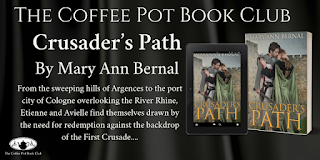
The Plight of the LepersMary Ann Bernal
Leprosy (Hansen’s Disease) has been around long before 1550 B.C. when the infection was first documented in ancient Egypt and other countries. The culprit behind the now-treatable disorder is Mycobacterium leprae, a bacterium related to the tuberculosis strain.
Recapping some of the symptoms include disfigurement, claw hands, skin lesions, nerve damage, muscle weakness, and a collapsed nose. The contagion is spread through skin contact and respiratory secretions. While leprosy is contagious, it never reached pandemic proportions. Meaning, isolating the poor souls was never necessary, so much heartbreak because of ignorance.
Leviticus 14 provides a recipe for a “cure” where bird blood is sprinkled over the affected person. Throughout the ages, dog and lamb blood was used to either drink or bathe in. Desperation leads to desperate measures as witnessed by the various odd treatments using snake venom, frog poison, bee and scorpion stings, and chaulmoogra oil to apply on the lesions. Worse yet was the use of arsenic and castration, believing the disease was sexually transmitted.
Fear and superstition held a firm grip on societal mores. Why were lepers shunned? Was it because of Leviticus? Was it not written the afflicted were unclean? And of course, the inference for causation was sin. Even though the New Testament states, Jesus healed lepers while forgiving sins, mankind was not as forgiving.
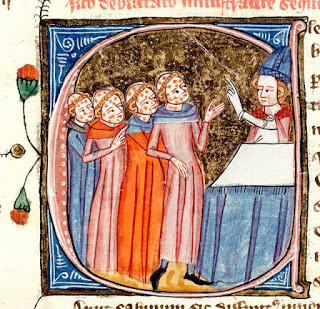 Leprosy victims taught by bishop — Wikipedia.
Leprosy victims taught by bishop — Wikipedia.
Leviticus states lepers are unclean and sinful. The afflicted were shunned, forced to live in caves during Biblical times, and in colonies as the centuries passed. Laws were enacted to protect the population. Lepers lost their rights. They were declared legally dead, forced to participate in a ritual where they stood in an open grave as the damming words were read. They became the living dead. Their property was confiscated; all their wealth went into governmental coffers. They were denied entry to places inhabited by healthy people.
Leper houses and asylums became prominent throughout all of Christendom in the Middle Ages. If not confined, the lepers had to follow harsh rules. They had to wear special clothing and play a wooden clapper, later a bell, to warn of their approach. They also had to take vows listed in the Mass of Separation. And yes, rich lepers fared better than poor ones.
It is hard to visualize a beloved family member being treated with disdain, ostracized by the community, and forced to live a life of misery, begging for alms, bereft of hope. Can you imagine yourself having to ring a bell as you approached the local mall, warning people of your imminent arrival? You probably wouldn’t have made it out of the parking lot before the Police arrived.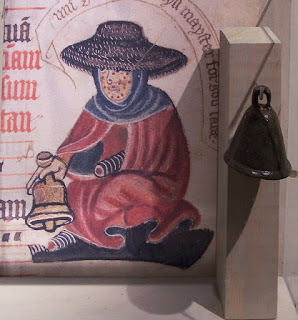 Medieval leper bell at the museum Ribes Vikinger, Ribe, Denmark — Wikipedia.
Medieval leper bell at the museum Ribes Vikinger, Ribe, Denmark — Wikipedia.
Grant it, catching a disease was very scary throughout time. We still shy away from people infected with some respiratory disease, sending sick workers home. How many times have you heard “I’m not contagious” when greeting someone who has a runny nose and coughs a lot? And remember how patients with AIDS were treated when the disease was first diagnosed? Fear and ignorance reigned, just like it did when lepers walked the countryside in days of old. At least, today, we are fortunate to have science to explain the unexplainable. We have the Centers for Disease Control and Prevention (CDC). While we are much better off than our forebearers, we still have a long way to go to eradicate the fear and educate the ignorant.
Hawaii’s leper colony is located at Kalaupapa, on the island of Molokai. It housed thousands of infected people since its inception in 1866. The statement by Makia Malo is a stark reminder of society’s failure to embrace the truth.
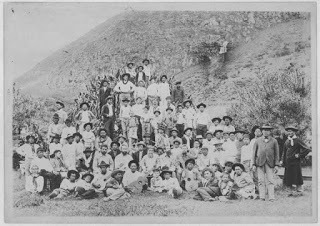 Kalaupapa leper colony in 1905 Wikipedia.
Kalaupapa leper colony in 1905 Wikipedia.
In 2003, patient Makia Malo said to the Associated Press, “One of the worst things about having had this disease is that even after you're cured, society will not let you heal because of the 'L' word. People don't know how hurtful and wrong that term is.”
The word leper is synonymous with outcast and is offensive to modern-day sufferers of the disease. While using the medical term, Hansen’s disease, is preferable, an acceptable alternative is stating the person has leprosy.
Leprosy is a curable disease today, but there are still people being crippled by this wretched pestilence. India, Brazil, and Indonesia have the highest rate of infection.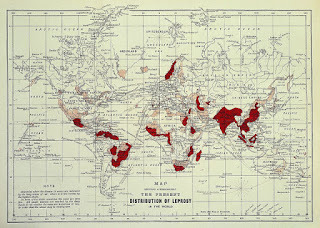 Distribution of leprosy around the world Wellcome— Wikipedia.
Distribution of leprosy around the world Wellcome— Wikipedia.
World Leprosy Day is observed on the last Sunday in January.
Crusader’s PathBy Mary Ann Bernal

From the sweeping hills of Argences to the port city of Cologne overlooking the River Rhine, Etienne and Avielle find themselves drawn by the need for redemption against the backdrop of the First Crusade.
Heeding the call of His Holiness, Urban II, to free the Holy Land from the infidel, Etienne follows Duke Robert of Normandy across the treacherous miles, braving sweltering heat and snow-covered mountain passes while en route to the Byzantine Empire.
Moved by Peter of Amiens’ charismatic rhetoric in the streets of the Holy Roman Empire, Avielle joins the humble army of pilgrims. Upon arrival in Mentz, the peasant Crusaders do the unthinkable, destroying the Jewish Community. Consumed with guilt, Avielle is determined to die fighting for Christ, assuring her place in Heaven.
Etienne and Avielle cross paths in Constantinople, where they commiserate over past misdeeds. A spark becomes a flame, but when Avielle contracts leprosy, Etienne makes a promise to God, offering to take the priest cowl in exchange for ridding Avielle of her affliction.
Will Etienne be true to his word if Avielle is cleansed of the contagion, or will he risk eternal damnation to be with the woman he loves?
Pick up your copy ofCrusader’s PathAmazon
Mary Ann Bernal
 Mary Ann Bernal attended Mercy College, Dobbs Ferry, NY, where she received a degree in Business Administration. Her literary aspirations were ultimately realized when the first book of The Briton and the Dane novels was published in 2009. In addition to writing historical fiction, Mary Ann has also authored a collection of contemporary short stories in the Scribbler Tales series. Her latest endeavor is a science fiction/fantasy novel entitled Planetary Wars Rise of an Empire. Originally hailing from New York, Mary Ann now resides in Elkhorn, Nebraska.
Mary Ann Bernal attended Mercy College, Dobbs Ferry, NY, where she received a degree in Business Administration. Her literary aspirations were ultimately realized when the first book of The Briton and the Dane novels was published in 2009. In addition to writing historical fiction, Mary Ann has also authored a collection of contemporary short stories in the Scribbler Tales series. Her latest endeavor is a science fiction/fantasy novel entitled Planetary Wars Rise of an Empire. Originally hailing from New York, Mary Ann now resides in Elkhorn, Nebraska.
Connect with Mary Ann: Website • Whispering Legends Press • Twitter.
Join #HistoricalFiction author, Mary Ann Bernal, as she takes a look back in time to the plight of the Lepers. There is also a chance to check out Mary Ann’s fabulous new book — Crusader’s Path #History @BritonandDane

The Plight of the LepersMary Ann Bernal
Leprosy (Hansen’s Disease) has been around long before 1550 B.C. when the infection was first documented in ancient Egypt and other countries. The culprit behind the now-treatable disorder is Mycobacterium leprae, a bacterium related to the tuberculosis strain.
Recapping some of the symptoms include disfigurement, claw hands, skin lesions, nerve damage, muscle weakness, and a collapsed nose. The contagion is spread through skin contact and respiratory secretions. While leprosy is contagious, it never reached pandemic proportions. Meaning, isolating the poor souls was never necessary, so much heartbreak because of ignorance.
Leviticus 14 provides a recipe for a “cure” where bird blood is sprinkled over the affected person. Throughout the ages, dog and lamb blood was used to either drink or bathe in. Desperation leads to desperate measures as witnessed by the various odd treatments using snake venom, frog poison, bee and scorpion stings, and chaulmoogra oil to apply on the lesions. Worse yet was the use of arsenic and castration, believing the disease was sexually transmitted.
Fear and superstition held a firm grip on societal mores. Why were lepers shunned? Was it because of Leviticus? Was it not written the afflicted were unclean? And of course, the inference for causation was sin. Even though the New Testament states, Jesus healed lepers while forgiving sins, mankind was not as forgiving.
 Leprosy victims taught by bishop — Wikipedia.
Leprosy victims taught by bishop — Wikipedia. Leviticus states lepers are unclean and sinful. The afflicted were shunned, forced to live in caves during Biblical times, and in colonies as the centuries passed. Laws were enacted to protect the population. Lepers lost their rights. They were declared legally dead, forced to participate in a ritual where they stood in an open grave as the damming words were read. They became the living dead. Their property was confiscated; all their wealth went into governmental coffers. They were denied entry to places inhabited by healthy people.
Leper houses and asylums became prominent throughout all of Christendom in the Middle Ages. If not confined, the lepers had to follow harsh rules. They had to wear special clothing and play a wooden clapper, later a bell, to warn of their approach. They also had to take vows listed in the Mass of Separation. And yes, rich lepers fared better than poor ones.
It is hard to visualize a beloved family member being treated with disdain, ostracized by the community, and forced to live a life of misery, begging for alms, bereft of hope. Can you imagine yourself having to ring a bell as you approached the local mall, warning people of your imminent arrival? You probably wouldn’t have made it out of the parking lot before the Police arrived.
 Medieval leper bell at the museum Ribes Vikinger, Ribe, Denmark — Wikipedia.
Medieval leper bell at the museum Ribes Vikinger, Ribe, Denmark — Wikipedia.Grant it, catching a disease was very scary throughout time. We still shy away from people infected with some respiratory disease, sending sick workers home. How many times have you heard “I’m not contagious” when greeting someone who has a runny nose and coughs a lot? And remember how patients with AIDS were treated when the disease was first diagnosed? Fear and ignorance reigned, just like it did when lepers walked the countryside in days of old. At least, today, we are fortunate to have science to explain the unexplainable. We have the Centers for Disease Control and Prevention (CDC). While we are much better off than our forebearers, we still have a long way to go to eradicate the fear and educate the ignorant.
Hawaii’s leper colony is located at Kalaupapa, on the island of Molokai. It housed thousands of infected people since its inception in 1866. The statement by Makia Malo is a stark reminder of society’s failure to embrace the truth.
 Kalaupapa leper colony in 1905 Wikipedia.
Kalaupapa leper colony in 1905 Wikipedia.In 2003, patient Makia Malo said to the Associated Press, “One of the worst things about having had this disease is that even after you're cured, society will not let you heal because of the 'L' word. People don't know how hurtful and wrong that term is.”
The word leper is synonymous with outcast and is offensive to modern-day sufferers of the disease. While using the medical term, Hansen’s disease, is preferable, an acceptable alternative is stating the person has leprosy.
Leprosy is a curable disease today, but there are still people being crippled by this wretched pestilence. India, Brazil, and Indonesia have the highest rate of infection.
 Distribution of leprosy around the world Wellcome— Wikipedia.
Distribution of leprosy around the world Wellcome— Wikipedia.World Leprosy Day is observed on the last Sunday in January.
Crusader’s PathBy Mary Ann Bernal

From the sweeping hills of Argences to the port city of Cologne overlooking the River Rhine, Etienne and Avielle find themselves drawn by the need for redemption against the backdrop of the First Crusade.
Heeding the call of His Holiness, Urban II, to free the Holy Land from the infidel, Etienne follows Duke Robert of Normandy across the treacherous miles, braving sweltering heat and snow-covered mountain passes while en route to the Byzantine Empire.
Moved by Peter of Amiens’ charismatic rhetoric in the streets of the Holy Roman Empire, Avielle joins the humble army of pilgrims. Upon arrival in Mentz, the peasant Crusaders do the unthinkable, destroying the Jewish Community. Consumed with guilt, Avielle is determined to die fighting for Christ, assuring her place in Heaven.
Etienne and Avielle cross paths in Constantinople, where they commiserate over past misdeeds. A spark becomes a flame, but when Avielle contracts leprosy, Etienne makes a promise to God, offering to take the priest cowl in exchange for ridding Avielle of her affliction.
Will Etienne be true to his word if Avielle is cleansed of the contagion, or will he risk eternal damnation to be with the woman he loves?
Pick up your copy ofCrusader’s PathAmazon
Mary Ann Bernal
 Mary Ann Bernal attended Mercy College, Dobbs Ferry, NY, where she received a degree in Business Administration. Her literary aspirations were ultimately realized when the first book of The Briton and the Dane novels was published in 2009. In addition to writing historical fiction, Mary Ann has also authored a collection of contemporary short stories in the Scribbler Tales series. Her latest endeavor is a science fiction/fantasy novel entitled Planetary Wars Rise of an Empire. Originally hailing from New York, Mary Ann now resides in Elkhorn, Nebraska.
Mary Ann Bernal attended Mercy College, Dobbs Ferry, NY, where she received a degree in Business Administration. Her literary aspirations were ultimately realized when the first book of The Briton and the Dane novels was published in 2009. In addition to writing historical fiction, Mary Ann has also authored a collection of contemporary short stories in the Scribbler Tales series. Her latest endeavor is a science fiction/fantasy novel entitled Planetary Wars Rise of an Empire. Originally hailing from New York, Mary Ann now resides in Elkhorn, Nebraska.Connect with Mary Ann: Website • Whispering Legends Press • Twitter.
Published on April 30, 2020 23:00
April 27, 2020
The Coffee Pot Book Club: #BookReview — Crusader's Path by Mary Ann Bernal
The Coffee Pot Book Club: #BookReview — Crusader's Path by Mary Ann Bernal #...: Crusader's Path By Mary Ann Bernal From the sweeping hills of Argences to the port city of Cologne overlooking the ...
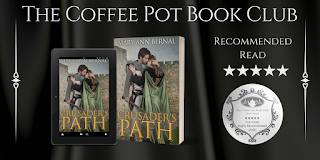 Crusader's PathBy Mary Ann Bernal
Crusader's PathBy Mary Ann Bernal


"Did not the walls of Jericho fall after the Israelites walked around them? … Is not our faith equal to theirs, if not greater?"
Etienne d'Argences did not need much encouragement to heed the call of His Holiness, Urban II. If Duke Robert of Normandy intended to fight in this Holy War, then Etienne would as well.
Avielle had to get away from Cologne, for there is nothing left there for her but bittersweet memories. When Avielle hears Peter of Amiens' sermon, she feels compelled to join his army and march towards Jerusalem.
But when Avielle reaches Constantinople, her life is irrevocably changed forever...
From the mountain tops of Cologne, where the lepers made their home, to the Siege of Jerusalem, Crusader's Path by Mary Ann Bernal is the unforgettable story of two people who find love amongst the carnage of the First Crusade.
What a journey Bernal takes her readers on! Crusader's Path is a richly detailed and emotionally charged story that is utterly unputdownable. With carefully crafted prose and a narrative that is as lucid as it is detailed, Bernal shows us what the Holy War was like for both the Crusaders and those who got in the way of their goal. It is a story of sacrifice and loss, but above everything else, it is a story of love. This is the kind of book that sends shivers down your spine.
The heroine of this tale is a young woman called Avielle. Having suffered so greatly with the loss of her father to leprosy, Avielle has great compassion for the sick and the shunned. She risks her health, and indeed her own life, to nurse those with the disease. Avielle trusts God to keep her safe — a trust that is sometimes misplaced. And yet, her faith isn't shaken, and she continues to look to Him for guidance. Her story is a tragic one. She is a lost lamb that seems forever out of reach of the Good Shepherd. Avielle also carries a tremendous burden of guilt which leads her to some extraordinary situations. She feels compelled to follow Peter's Crusade to the Holy Land, where she witnesses the most appalling atrocities, which makes her question the holiness of the army she is following. However, she is still convinced in divine intervention and indeed, when Avielle chooses to follow her own path and not one ordained by God, she finds herself in the most desperate of situations. Avielle is an extraordinarily complex heroine who is almost like a feather caught in the breeze — she does not quite know where she is going to land. I thought Bernal portrayed Avielle with great skill and diligence. I really enjoyed reading about her and this perilous journey that she finds herself on.
Etienne d'Argences is an intriguing protagonist who is pulled in several very different directions during this book. He single-mindedly pursues his own desires. He is determined to follow Duke Robert wherever he may lead, but by doing so, he sacrifices many people along the way, including his wife. Often Etienne finds himself conflicted between reason and emotion — he knows his wife needs him, but when he is at his estate with the people who love him, he feels stifled and he cannot wait to leave again. Initially, he sees love as an obstacle that he has to overcome, and it isn't until he meets Avielle that he realises that love should have been his goal all along. Bernal has really captured the essence of a Crusader who longs for adventure and the comradeship of his Lord and fellow knights. His relationship with Duke Robert is an interesting one — it is not the usual relationship one would expect to find between a Duke and his knight — they are each other's confidante and above everything else, best friends. His relationship with Avielle has a similar feel to it, except romantic love is also added to the equation. I adored Etienne, and I enjoyed reading about him.
This portrayal of love in Crusader's Path is slightly different when compared to what one would expect from a traditional historical romance. It takes a while for the two protagonists to find each other, which worked exceptionally well for this story. Etienne and Avielle's love is forged in the fires of a Holy War. Their love is a welcomed relief to the horrors of the battlefield and the sickroom. But it is also a love that cannot be withheld, despite the social difference between the two. Etienne and Avielle are not looking for love when they find each other, but they both recognise that they are meant to be together, which is exceedingly romantic.
Bernal has masterfully depicted the horrors of the First Crusade. There are some profoundly upsetting scenes in this book, and there are certainly many casualties in this war. Bernal's portrayal of what became known in history as the Rhineland Massacres of the Jews, in particular, the persecution and the destruction of Jewish communities in Mentz (Mainz) left me reaching for the tissues. The Siege of Antioch was also particularly well-drawn — Bernal captured the horrors in the Crusader's camp as food ran scare and disease took hold. She also demonstrated the rivalry between Godfrey of Bouillon and Raymond IV, Count of Toulouse, fabulously. The historical detailing in this book is staggering. Bernal has captured the very essence of what it must have been like to follow men such as Peter of Amiens (Peter the Hermit) and The Army of Robert Curthose of Normandy which was led by Robert, Duke of Normandy.
If you are looking for your next great Historical Fiction book then look no further than Crusader's Path by Mary Ann Bernal. I think this may well be Bernal's best book yet!
I Highly Recommend.
Review by Mary Anne Yarde.The Coffee Pot Book Club.
Pick up your copy ofCrusader's PathAmazon UK • Amazon US
 Crusader's PathBy Mary Ann Bernal
Crusader's PathBy Mary Ann Bernal


"Did not the walls of Jericho fall after the Israelites walked around them? … Is not our faith equal to theirs, if not greater?"
Etienne d'Argences did not need much encouragement to heed the call of His Holiness, Urban II. If Duke Robert of Normandy intended to fight in this Holy War, then Etienne would as well.
Avielle had to get away from Cologne, for there is nothing left there for her but bittersweet memories. When Avielle hears Peter of Amiens' sermon, she feels compelled to join his army and march towards Jerusalem.
But when Avielle reaches Constantinople, her life is irrevocably changed forever...
From the mountain tops of Cologne, where the lepers made their home, to the Siege of Jerusalem, Crusader's Path by Mary Ann Bernal is the unforgettable story of two people who find love amongst the carnage of the First Crusade.
What a journey Bernal takes her readers on! Crusader's Path is a richly detailed and emotionally charged story that is utterly unputdownable. With carefully crafted prose and a narrative that is as lucid as it is detailed, Bernal shows us what the Holy War was like for both the Crusaders and those who got in the way of their goal. It is a story of sacrifice and loss, but above everything else, it is a story of love. This is the kind of book that sends shivers down your spine.
The heroine of this tale is a young woman called Avielle. Having suffered so greatly with the loss of her father to leprosy, Avielle has great compassion for the sick and the shunned. She risks her health, and indeed her own life, to nurse those with the disease. Avielle trusts God to keep her safe — a trust that is sometimes misplaced. And yet, her faith isn't shaken, and she continues to look to Him for guidance. Her story is a tragic one. She is a lost lamb that seems forever out of reach of the Good Shepherd. Avielle also carries a tremendous burden of guilt which leads her to some extraordinary situations. She feels compelled to follow Peter's Crusade to the Holy Land, where she witnesses the most appalling atrocities, which makes her question the holiness of the army she is following. However, she is still convinced in divine intervention and indeed, when Avielle chooses to follow her own path and not one ordained by God, she finds herself in the most desperate of situations. Avielle is an extraordinarily complex heroine who is almost like a feather caught in the breeze — she does not quite know where she is going to land. I thought Bernal portrayed Avielle with great skill and diligence. I really enjoyed reading about her and this perilous journey that she finds herself on.
Etienne d'Argences is an intriguing protagonist who is pulled in several very different directions during this book. He single-mindedly pursues his own desires. He is determined to follow Duke Robert wherever he may lead, but by doing so, he sacrifices many people along the way, including his wife. Often Etienne finds himself conflicted between reason and emotion — he knows his wife needs him, but when he is at his estate with the people who love him, he feels stifled and he cannot wait to leave again. Initially, he sees love as an obstacle that he has to overcome, and it isn't until he meets Avielle that he realises that love should have been his goal all along. Bernal has really captured the essence of a Crusader who longs for adventure and the comradeship of his Lord and fellow knights. His relationship with Duke Robert is an interesting one — it is not the usual relationship one would expect to find between a Duke and his knight — they are each other's confidante and above everything else, best friends. His relationship with Avielle has a similar feel to it, except romantic love is also added to the equation. I adored Etienne, and I enjoyed reading about him.
This portrayal of love in Crusader's Path is slightly different when compared to what one would expect from a traditional historical romance. It takes a while for the two protagonists to find each other, which worked exceptionally well for this story. Etienne and Avielle's love is forged in the fires of a Holy War. Their love is a welcomed relief to the horrors of the battlefield and the sickroom. But it is also a love that cannot be withheld, despite the social difference between the two. Etienne and Avielle are not looking for love when they find each other, but they both recognise that they are meant to be together, which is exceedingly romantic.
Bernal has masterfully depicted the horrors of the First Crusade. There are some profoundly upsetting scenes in this book, and there are certainly many casualties in this war. Bernal's portrayal of what became known in history as the Rhineland Massacres of the Jews, in particular, the persecution and the destruction of Jewish communities in Mentz (Mainz) left me reaching for the tissues. The Siege of Antioch was also particularly well-drawn — Bernal captured the horrors in the Crusader's camp as food ran scare and disease took hold. She also demonstrated the rivalry between Godfrey of Bouillon and Raymond IV, Count of Toulouse, fabulously. The historical detailing in this book is staggering. Bernal has captured the very essence of what it must have been like to follow men such as Peter of Amiens (Peter the Hermit) and The Army of Robert Curthose of Normandy which was led by Robert, Duke of Normandy.
If you are looking for your next great Historical Fiction book then look no further than Crusader's Path by Mary Ann Bernal. I think this may well be Bernal's best book yet!
I Highly Recommend.
Review by Mary Anne Yarde.The Coffee Pot Book Club.
Pick up your copy ofCrusader's PathAmazon UK • Amazon US
Published on April 27, 2020 23:30
April 26, 2020
The Briton and the Dane: Timeline by Mary Ann Bernal
Dr. Gwyneth Franger is a renowned expert in early medieval England who is set upon learning the truth about the death of Lord Erik, the last descendant of the powerful House of Wareham. Her quest becomes an obsession, a condition that began with the discovery of a portrait of the tall and valiant warrior with which she forms an extraordinary and inexplicable bond.
Digesting troves of mildewed scrolls and source documentation only enhances her belief that Lord Erik was brutally assassinated by a cabal of traitors in the pay of William the Bastard, shortly before the onslaught of the Norman Invasion.
On an archeological dig in Southern England, her team unearths an Anglo-Saxon fortress, a vast citadel built during the reign of Alfred the Great, which she believes was Lord Erik’s stronghold. In the midst of her excitement, she is awakened one night from her slumbers by a disconcerting anomaly emerging from the site.
Dr. Franger finds herself transported back to the Dark Ages and at the side of the noble Lord Erik who commands an army of elite Saxon warriors, a swift and mobile force able to deploy quickly throughout the kingdom to ward off invaders.
Witnessing the unrest firsthand, Gwyneth senses that her instincts had been right all along, and she is determined to learn the identities of the treacherous blackguards hiding in the shadows, villains who may well be posing as Lord Erik’s friends and counselors.
Will Gwyneth stop the assassins? Is she strong enough to walk away and watch her beloved Erik die? Or will she intervene, change the course of history and wipe out an entire timeline to save the man she loves with all her heart?

PurchaseAmazon Global LinkAudibleBarnes and NobleiTunes/Apple Books
Smashwords
Published on April 26, 2020 23:30
April 25, 2020
Book Spotlight: The Du Lac Curse: Book 5 of The Du Lac Chronicles by Mary Anne Yarde
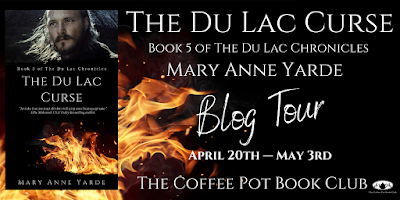
God against Gods. King against King. Brother against Brother.
Mordred Pendragon had once said that the sons of Lancelot would eventually destroy each other, it seemed he was right all along.
Garren du Lac knew what the burning pyres meant in his brother's kingdom — invasion. But who would dare to challenge King Alden of Cerniw for his throne? Only one man was daring enough, arrogant enough, to attempt such a feat — Budic du Lac, their eldest half-brother.
While Merton du Lac struggles to come to terms with the magnitude of Budic's crime, there is another threat, one that is as ancient as it is powerful. But with the death toll rising and his men deserting who will take up the banner and fight in his name?
Excerpt
It had been a long time since Guinevere had last ridden a horse. She had loved galloping with the wind in her hair when she was a young girl, but youth was far behind her now. And yet, when she had first looked upon Alden du Lac, the years had rolled away and she was that shy young girl again, looking into the face of the man she had once loved. Alden looked so much like his father that it hurt her eyes and broke her heart to look upon him. Sister Agatha had once told her that time heals all wounds. But that was not true… A heart, once broken, can never be mended. You just learned to live with the pain.
Fate had been cruel, but Guinevere had tried her best not to become bitter. She had been made to marry a Pendragon, but her heart had always been faithful to the House of Du Lac. “Lancelot,” she whispered the name of the only man she had ever loved under her breath. Alden was what she had foolishly once imagined her own son would look like. Only there had been no son, just as there had been no future with the man she had loved. In the end, it was the Church that had saved, not only her life, but also her sanity. No one could stop her from loving God, and God would never stop loving her, no matter what.
And yet, here she was once again choosing Lancelot over God — choosing Lancelot over everything. The child whimpered, and she held onto him a little tighter.
“Shh, be brave,” she soothed.
“I want my Mother,” Jowan, Alden’s six-year-old son and heir, said as he sniffed back his tears.
“I know you do.” Guinevere wanted to reassure the child, tell him that he would see his mother soon. But she would not lie to him. She had been lied to as a child. She had been told that her mother had gone away for a few days, and then when her mother had not returned, she had been told that her mother had been delayed. Only she had not been delayed. She was dead. Guinevere may have been young, but she would have rather been told the truth from the start than to live a lie for two years before her father thought her old enough to understand.
Guinevere kicked the horse on again, and the child fell silent. Guinevere knew what she had to do, but that did not mean she did not have grave misgivings. Guinevere did not know how she would be received, but for the sake of Lancelot’s grandson, she would put aside their differences and ask… No, she would get down on her knees and beg this knight for help. It was the only thing she could do. It was that, or run away. Guinevere had been running for too long. She had been running from her past for years. It was about time she stopped.
Where to BuyAmazon USAmazon UK
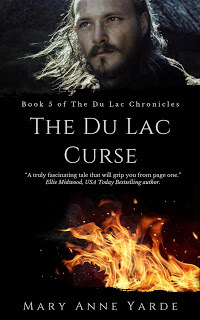
About the Author

Mary Anne Yarde is the multi award-winning author of the International Bestselling Series — The Du Lac Chronicles. Set a generation after the fall of King Arthur, The Du Lac Chronicles takes you on a journey through Dark Age Britain and Brittany, where you will meet new friends and terrifying foes. Based on legends and historical fact, The Du Lac Chronicles is a series not to be missed.
Born in Bath, England, Mary Anne Yarde grew up in the southwest of England, surrounded and influenced by centuries of history and mythology. Glastonbury — the fabled Isle of Avalon — was a mere fifteen-minute drive from her home, and tales of King Arthur and his knights were part of her childhood.
Connect with the AuthorWebsiteBlogTwitterFacebookGoodreads
Published on April 25, 2020 23:30
April 21, 2020
The Briton and the Dane: Concordia by Mary Ann Bernal
Travel back in time to late Ninth Century Anglo-Saxon Britain where Alfred the Great rules with a benevolent hand while the Danish King rules peacefully within the boundaries of the Danelaw. Trade flourishes, and scholars from throughout the civilized world flock to Britannia’s shores to study at the King’s Court School at Winchester.
Enter Concordia, a beautiful noblewoman whose family is favored by the king. Vain, willful, and admired, but ambitious and cunning, Concordia is not willing to accept her fate. She is betrothed to the valiant warrior, Brantson, but sees herself as far too young to lay in the bedchamber of an older suitor. She wants to see the wonders of the world, embracing everything in it; preferably, but dangerously, at the side of Thayer, the exotic Saracen who charms King Alfred’s court and ignites her yearning passions.
Concordia manipulates her besotted husband into taking her to Rome, but her ship is captured by bloodthirsty pirates, and the seafarers protecting her are ruthlessly slain to a man. As she awaits her fate in the Moorish captain’s bed, by sheer chance, she discovers that salvation is at hand in the gilded court of a Saracen nobleman.
While awaiting rescue, Concordia finds herself at the center of intrigue, plots, blackmail, betrayal and the vain desires of two egotistical brothers, each willing to die for her favor. Using only feminine cunning, Concordia must defend her honor while plotting her escape as she awaits deliverance, somewhere inside steamy, unconquered Muslim Hispania.

PurchaseAmazon Global LinkAudibleBarnes and NobleiTunes/Apple Books
Smashwords
Published on April 21, 2020 23:30
April 20, 2020
Spotlight on novelist Mercedes Rochelle

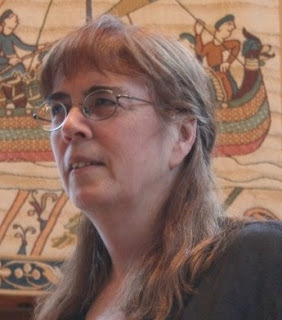
Mercedes Rochelle
Fun Facts
Oh dear, I’m very shy about making myself the center of attention. That’s the first thing you didn’t know about me. Even when I got married, I was embarrassed about all the fuss (we had the ceremony on our back porch). In school, I loved sitting in the back of the room. It’s very hard for me to make announcements about my own books, which is why I like blog tours!
The second thing you don’t know about me is that I love tchotchke. Not just little baubles, but especially tacky lamps. See? Isn’t that fun?


What writer could live without such inspiration?
The third thing you don’t know about me is that I live in a log home that we built ourselves. Well, we didn’t wield the hammer, but we did design the house ourselves. The arts-and-crafts stonework on the dormers was my idea.

The fourth thing you don’t know about me is my love of artwork. I was self-taught by osmosis; I searched through hundreds of art books. Thirty years ago—way before the internet—I compiled three art indexes arranged by subject: Historical Art Index A.D. 400-1650, Mythological and Classical World Art Index, and Post-Biblical Saints Art Index. These three library books garnered royalties somewhere around $10,000 total, and I thought I was being screwed. Little did I know!
The fifth thing you don’t know about me is I have a weakness for cheese and crackers—specifically Triscuits—and wine. And pistachios. I indulge myself almost every evening. I eat my heavy meal at lunchtime and keep it light in the evening. Life is good. ***The King’s Retribution: Book 2 of The Plantagenet Legacy

If you read A KING UNDER SIEGE, you might remember that we left off just as Richard declared his majority at age 22. He was able to rise above the humiliation inflicted on him during the Merciless Parliament, but the fear that it could happen again haunted him the rest of his life. Ten years was a long time to wait before taking revenge on your enemies, but King Richard II was a patient man. Hiding his antagonism toward the Lords Appellant, once he felt strong enough to wreak his revenge he was swift and merciless. Alas for Richard, he went too far, and in his eagerness to protect his crown Richard underestimated the very man who would take it from him: Henry Bolingbroke.***About the AuthorMercedes Rochelle
Born in St. Louis MO with a degree from the University of Missouri, Mercedes Rochelle learned about living history as a re-enactor and has been enamored with historical fiction ever since. A move to New York to do research and two careers ensued, but writing fiction remains her primary vocation. She lives in Sergeantsville, NJ with her husband in a log home they had built themselves.
***Where to Buy
Amazon USAmazon UK
***
Connect with the author
WebsiteBlogFacebookTwitter
Published on April 20, 2020 23:00
April 15, 2020
The Briton and the Dane: The Complete Trilogy by Mary Ann Bernal
The Briton and the Dane novels bring to life the tumultuous ninth century when the formidable Vikings terrorized the civilized world. The epic adventure runs the gamut of deception, treachery, intrigue, and betrayal during a time of war and conquest in Anglo-Saxon Britain.
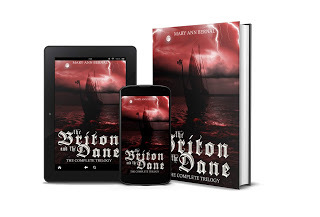
PurchaseAmazon Global LinkAudibleBarnes and NobleiTunes/Apple Books
Smashwords
Published on April 15, 2020 23:00
April 12, 2020
New Release - Crusader's Path by Mary Ann Bernal
From the sweeping hills of Argences to the port city of Cologne overlooking the River Rhine, Etienne and Avielle find themselves drawn by the need for redemption against the backdrop of the First Crusade.
Heeding the call of His Holiness, Urban II, to free the Holy Land from the infidel, Etienne follows Duke Robert of Normandy across the treacherous miles, braving sweltering heat and snow-covered mountain passes while en route to the Byzantine Empire.
Moved by Peter of Amiens’ charismatic rhetoric in the streets of the Holy Roman Empire, Avielle joins the humble army of pilgrims. Upon arrival in Mentz, the peasant Crusaders do the unthinkable, destroying the Jewish Community. Consumed with guilt, Avielle is determined to die fighting for Christ, assuring her place in Heaven.
Etienne and Avielle cross paths in Constantinople, where they commiserate over past misdeeds. A spark becomes a flame, but when Avielle contracts leprosy, Etienne makes a promise to God, offering to take the priest cowl in exchange for ridding Avielle of her affliction.
Will Etienne be true to his word if Avielle is cleansed of the contagion, or will he risk eternal damnation to be with the woman he loves?
Excerpt
At first light, Avielle headed to the Bishop’s residence. She had not requested an audience and was surprised to receive such a command. She wondered why the Bishop wanted to see her. Perhaps, to change her mind about joining Duke Robert’s Army? Or he might wish to thank her for serving the Lord’s flock all these months or having the foresight to build the new hospital or both?
Unless I still require the Bishop’s approval for joining His Holiness’s campaign?
The Bishop rarely stayed in his assigned quarters at the Abbey, preferring to conduct church business on the grounds given to him by the Emperor. The small fortification was not far from the royal palace and was guarded by soldiers who had sworn their allegiance to him and not to the ruler of the Byzantine Empire.
Avielle paced herself, a long journey on foot, shorter if she had a donkey, faster if she had a horse. She pulled back her hood as the sun rose in the morning sky, regretting having worn the cloak at all once the heat of the day warmed the land. As Avielle reached the palace gates, she noticed soldiers holding the reins of six horses. She stopped when she saw the red flag with two leopards hanging listlessly on a lance. Should she stay, hoping to see the knight who had caught her eye or continue on her way? One did not keep the Bishop waiting!
At that moment, Duke Robert and his men crossed the courtyard. They mounted the horses in silence, riding slowly into the street. Etienne moved with his animal, as if they were one, riding on the side of the road where Avielle stood. She looked up, her face glowing when their eyes locked. A brief moment without words, a memory to reflect upon in the night, when unable to sleep. Avielle did not move, watching the knights returning from whence they came, and holding her breath when Etienne turned around, not once but twice before disappearing from her view.
If he is Duke Robert, he posed no threat, but if not?
A soldier Avielle had tended to at the hospital found her and offered to be of service.
“The Bishop expects me at his residence; I must not keep him waiting.”
“Ride with me,” the soldier said. “I am driving a cart filled with supplies for the Bishop’s kitchens.”
During the short journey, Avielle questioned the unsuspecting soldier about the leader of the Army encamped in the fields. She mentioned seeing six knights and could he identify any of them.
“I know only one name other than the ducal lord. A favored knight, who is called Etienne. They leave soon for the Holy Land.”
Etienne, is that who you are? Why do you haunt my thoughts?

PurchaseAmazon Global LinkAudibleBarnes and NobleiTunes/Apple Books
Smashwords
Published on April 12, 2020 00:00



